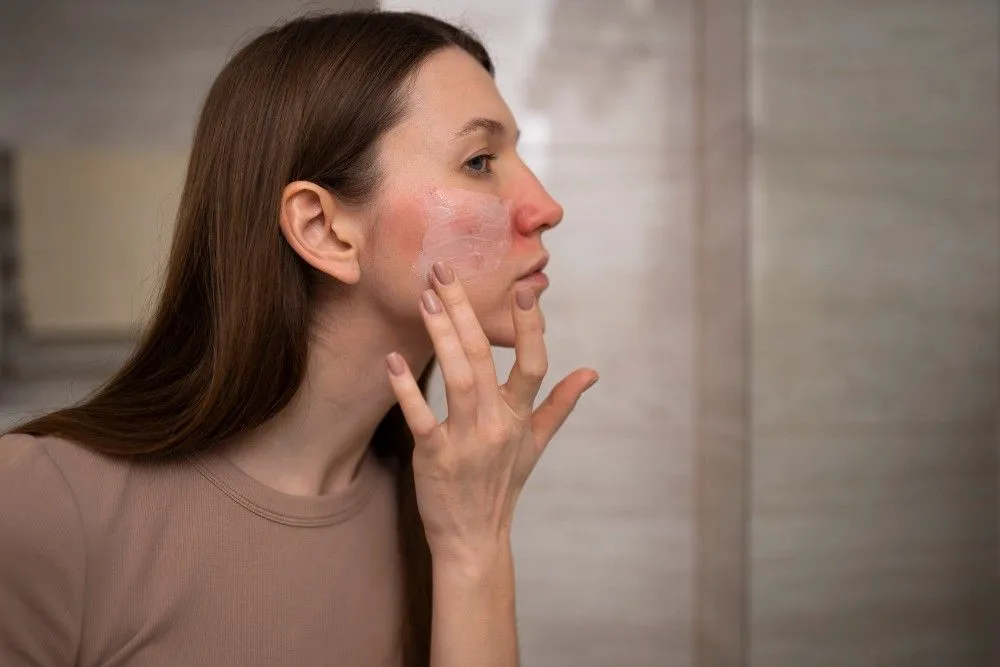Are you trying to wear your favorite necklace, but it was caught on a small, visible flap of skin at the base of your neck? Nothing to worry about, it's a skin tag.
Skin tags are soft, noncancerous growths that often appear in the folds of the skin on the neck, under the arms, between the breasts, in the groin, and on the eyelids. These lumps are loose collagen fibers stuck inside the skin's thicker layers. Many people will get skin tags, which are also very common. It is common to older people, those who are overweight, and those who have diabetes. Usually, the question that arises is how to remove skin tags.
While most skin tags are harmless and may disappear on their own. Skin tags may also be removed for cosmetic reasons, particularly on visible body parts like the face, neck, etc.
There are many tips on how to get rid of skin tags on your own, from toothpaste and apple cider vinegar to skin tag bands and patches. It depends on whether they function or are secure. Getting a skin tag removed by a dermatologist specializing in skin issues is recommended. So in this article, you will see methods to remove the skin tag with home remedies and some medical treatments; please continue reading to know more about removing skin tags.
 The causes of skin tag formation are unknown. Friction may be involved since they generally appear in skin wrinkles. It was made up of collagen and blood vessels that are covered in the outermost layer of skin.
Based on the studies, skin tags were linked with the human papillomavirus (HPV). Insulin resistance may also influence skin tag formation, resulting in type 2 diabetes and prediabetes. Multiple skin tags were linked to resistance to insulin, an increased body weight, and high triglycerides, based on a 2010 study. Another typical negative impact of pregnancy is skin tags. Weight gain and pregnancy hormones could be to blame for this. Rarely, having multiple skin tags may indicate an endocrine disorder or hormonal imbalance.
There could also be a genetic link. Skin tags, however, are not contagious.
Also, Read 10 Best Skin Whitening Creams in 2023
The causes of skin tag formation are unknown. Friction may be involved since they generally appear in skin wrinkles. It was made up of collagen and blood vessels that are covered in the outermost layer of skin.
Based on the studies, skin tags were linked with the human papillomavirus (HPV). Insulin resistance may also influence skin tag formation, resulting in type 2 diabetes and prediabetes. Multiple skin tags were linked to resistance to insulin, an increased body weight, and high triglycerides, based on a 2010 study. Another typical negative impact of pregnancy is skin tags. Weight gain and pregnancy hormones could be to blame for this. Rarely, having multiple skin tags may indicate an endocrine disorder or hormonal imbalance.
There could also be a genetic link. Skin tags, however, are not contagious.
Also, Read 10 Best Skin Whitening Creams in 2023
What causes skin tags?
 The causes of skin tag formation are unknown. Friction may be involved since they generally appear in skin wrinkles. It was made up of collagen and blood vessels that are covered in the outermost layer of skin.
Based on the studies, skin tags were linked with the human papillomavirus (HPV). Insulin resistance may also influence skin tag formation, resulting in type 2 diabetes and prediabetes. Multiple skin tags were linked to resistance to insulin, an increased body weight, and high triglycerides, based on a 2010 study. Another typical negative impact of pregnancy is skin tags. Weight gain and pregnancy hormones could be to blame for this. Rarely, having multiple skin tags may indicate an endocrine disorder or hormonal imbalance.
There could also be a genetic link. Skin tags, however, are not contagious.
Also, Read 10 Best Skin Whitening Creams in 2023
The causes of skin tag formation are unknown. Friction may be involved since they generally appear in skin wrinkles. It was made up of collagen and blood vessels that are covered in the outermost layer of skin.
Based on the studies, skin tags were linked with the human papillomavirus (HPV). Insulin resistance may also influence skin tag formation, resulting in type 2 diabetes and prediabetes. Multiple skin tags were linked to resistance to insulin, an increased body weight, and high triglycerides, based on a 2010 study. Another typical negative impact of pregnancy is skin tags. Weight gain and pregnancy hormones could be to blame for this. Rarely, having multiple skin tags may indicate an endocrine disorder or hormonal imbalance.
There could also be a genetic link. Skin tags, however, are not contagious.
Also, Read 10 Best Skin Whitening Creams in 2023
How to remove skin tags?
Here are a few effective ways to get rid of skin tags:1. Tea tree oil -
You might have heard that tea tree oil can cure skin tags. To use this technique, you must put one to two drops of tea tree oil on a cotton ball, place the cotton ball over the skin tag and bandage it for ten minutes, repeat three times a day. Since tea tree oil can irritate the skin, it might take several weeks before you notice any signs of improvement. Tea tree oil can cause allergic contact dermatitis in certain persons.2. Freezing -
Chemicals in over-the-counter freezing kits reduce the skin tag's temperature. The low temperature destroys unwanted skin tissue. OTC kits, however, do not reduce the temperature significantly for them to function. Before you observe any benefits, it can require many applications. Dermatologists' freezing technique is more successful than over-the-counter alternatives because they may use liquid nitrogen to reduce skin temperature. Also, Read White Spots in The Skin: Causes And Treatments3. Apple cider vinegar -
Apple cider vinegar's acidity breaks the skin tag's surrounding tissue, causing it to dissolve and fall off. Place a cotton pad over the skin tag after soaking it in apple cider vinegar. After 15 to 30 minutes of bandaging the area, remove the bandage and cleanse the skin. Repeat every day for a few weeks. Since apple cider vinegar is acidic, it may irritate the skin or even result in chemical burns. Redness and skin ulceration are other side effects.4. Vitamin E oil -
Applying vitamin E oil on a skin tag may cause the growth to disappear in a few days, as vitamin E is an antioxidant that fights wrinkling and maintains good skin. Skin health is aided by vitamin E. Although there is no evidence to back up this claim, applying vitamin E oil to the skin around the tag is said to cause it to shrink in a few days. While vitamin E won't harm the skin, some people may develop contact dermatitis, similar to tea tree oil.5. Removal creams -
In some situations, these creams are effective. Products with salicylic acid and tea tree oil should be avoided since they can irritate the skin or result in contact dermatitis. To guarantee that the skin absorbs the cream completely, instructions for using some of these creams suggest cleansing the skin with a cotton swab soaked in alcohol before applying the cream. The skin tag should disappear in two to three weeks, according to the labeling on some of these treatments.6. Skin Tag Patch -
You might find over-the-counter (OTC) skin tag patches at a nearby pharmacy. You cover your skin tag with a patch. The skin tag must come off when you remove it after allowing it on for a while. But there needs to be more proof that this approach works. Additionally, it may irritate the skin. Also, Read 10 Best Face Serum for Glowing Skin7. Skin tag Bands -
Bands used to remove skin tags are also known as ligations. This technique cuts the blood supply to the skin tag by wrapping a band around its stem. The skin tag's cells will degenerate once it stops receiving blood. The skin tag can then be twisted or peeled off when this has occurred. Dermatologists should carry out ligation. You run the danger of bleeding, infection, scarring, and only partially removing the skin tag, which might lead to it returning if you use skin tag removal bands on your own.8. Radiofrequency -
This technique has received approval from the Food and Drug Administration, which has said it is safe for several uses. Some doctors suggest radiofrequency as a less invasive technique for removing skin tags. In this procedure, the skin tag will be removed, and the bleeding will be stopped by heating the area with radio frequency or waves.9. Cryosurgery -
This typical procedure entails the surgeon blasting the skin tags with a very cold liquid of nitrogen or argon gas. As a result, the tag will get frozen and be released by the skin. It is a localized therapy that may be applied to particular body areas. However, freezing may worsen the skin's inflammatory response in the area. Moreover, considering the size and location of the skin tag, multiple treatments might be required.10. Electrosurgery -
Various skin lesions are treated using straightforward methods like electrosurgery, especially minor superficial lesions like skin tags and small angiomas. In this, a small electric current that passes through the skin tag and is heated by the current removes the skin tag.11. Surgery excision -
In this straightforward procedure, the surgeon will cut the tag free from the base using scissors. This procedure, done under local anesthetic, is unsuitable for individuals with diabetes or those who use blood thinners. Therefore, only select this course of treatment after consulting a specialist.12. Laser surgery -
Throughout this procedure, lasers heat the tags to remove them. Typically, a small wound from laser surgery will heal. Follow the doctor's instructions. Also, Read White Spots on Skin: Causes, Treatments, and PreventionWhat are the after-removal skin tag tips?
Skin tag removal often doesn't result in infections or other consequences. Some people experience post-removal scarring, which may eventually fade. Apply antibiotic cream to the area where you removed the skin tag at home, then bandage it up like you would a wound. If the region bleeds or gets uncomfortable, consult a doctor. Your doctor may advise maintaining your wound dry for at least 48 hours after a procedure to remove a skin tag before gently cleaning the area with soap and water. Additionally, your physician might arrange a follow-up appointment to examine the wound and remove any stitches. Also Read: The Best Acne-Fighting Skin Care RoutinesConclusion -
Skin tags don't need to be removed because they are mostly harmless. However, you should eliminate them if they keep bothering you. There are several methods available on how to remove skin tags, including freezing, cutting, and over-the-counter solutions, but it's crucial to consult with a healthcare professional before attempting any removal method. The risks of removing a skin tag at home include bleeding, infection, and scarring. By contacting an expert, you may reduce the dangers and ensure the growth does not result in a more serious issue like skin cancer. A dermatologist can safely remove skin tags using lasers, radio frequency, or cryosurgery.
Reviewed by







